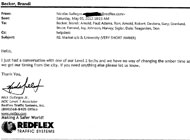Article from: www.thenewspaper.com/news/38/3883.asp
8/31/2012
California: City Conceals Red Light Camera Problems
Riverside, California keeps quiet about short yellows and vigilante attacks on its red light camera program.
 Cities that allow a private vendor to run a red light camera program often are reluctant to divulge any news that could cast doubt on the system's legitimacy or accuracy. Along these lines, Riverside, California has not been transparent regarding problems with the automated ticketing machines that have issued 161,199 citations, now worth nearly $500 each, since 2006. City documents obtained under the freedom of information laws reveal at least one intersection taking advantage of inadequate yellow signal timing and that cameras are silently being disabled by vigilantes.
Cities that allow a private vendor to run a red light camera program often are reluctant to divulge any news that could cast doubt on the system's legitimacy or accuracy. Along these lines, Riverside, California has not been transparent regarding problems with the automated ticketing machines that have issued 161,199 citations, now worth nearly $500 each, since 2006. City documents obtained under the freedom of information laws reveal at least one intersection taking advantage of inadequate yellow signal timing and that cameras are silently being disabled by vigilantes.
The intersection of University Avenue and Market Street is one of the city's least productive intersections, generating about $150,000 in revenue last year. In May, a city employee noticed the yellow signal timing on the left turn arrow was 0.7 seconds shorter than the bare minimum allowed under state regulations. The employee had been reviewing citations sent over by Redflex Traffic Systems of Australia, which mails the tickets after they are approved in large batches.
"Brandi, Incident #92566088 depicts 21453c violation however, with a very short 2.54 second amber," Arnold Paul wrote in a May 4 email to Public Works Administrative Analyst Brandi L. Becker. "Please refer this to city signal technician ASAP to insure the correct timing for the left turn arrow is set at 3.2 seconds and if any repairs need to be made to correct this problem."
In most cases, a yellow shortened by one second can increase the number of tickets a camera issues by 110 percent, according to a Texas Transportation Institute report. Longer yellows have a significant impact on red light camera intersections because the vast majority of straight-through red light "violations" happen when a driver misjudges the end of the yellow light by less than 0.25 seconds -- literally the blink of an eye (view chart). City employees realized the importance of fixing the timing, and Paul received a response within 15 minutes.
"I checked with the engineer in the TMC and she said the timing for the left arrow at SB Market/University is set at 3.2 seconds," Becker wrote. "Does this error occur in multiple violations? If so I will call for an emergency technician to physically check the intersection. Could it be a problem on the Redflex end?"
One month prior, Redflex reported serious problems at the intersection of Columbia Avenue and Main Street. Vigilantes more than once had succeeded in disabling the automated ticketing machine by opening up the system and slicing the connections.
"Peter received a call from one of the city signal techs that the base plate at our system was missing," Redflex Account Representative John Burnette wrote in an April 12 email to Becker. "Peter also received an automated message that the system was down. It appears vandals have once again severed the wires. Once Peter gives me an update, I will let you know the extent of the damage."
Riverside began discussions on whether the city should drop the use of the cameras in June after the California Department of Transportation (CalTrans) blocked renewal of permits at the most lucrative locations in the city. The HighwayRobbery.Net website has been lobbying CalTrans to reject the permits on the grounds that the eleven of the twelve accidents that happened prior to camera installation and were cited by city officials as justification for the cameras actually had nothing to do with red light running.
 Cities that allow a private vendor to run a red light camera program often are reluctant to divulge any news that could cast doubt on the system's legitimacy or accuracy. Along these lines, Riverside, California has not been transparent regarding problems with the automated ticketing machines that have issued 161,199 citations, now worth nearly $500 each, since 2006. City documents obtained under the freedom of information laws reveal at least one intersection taking advantage of inadequate yellow signal timing and that cameras are silently being disabled by vigilantes.
Cities that allow a private vendor to run a red light camera program often are reluctant to divulge any news that could cast doubt on the system's legitimacy or accuracy. Along these lines, Riverside, California has not been transparent regarding problems with the automated ticketing machines that have issued 161,199 citations, now worth nearly $500 each, since 2006. City documents obtained under the freedom of information laws reveal at least one intersection taking advantage of inadequate yellow signal timing and that cameras are silently being disabled by vigilantes.